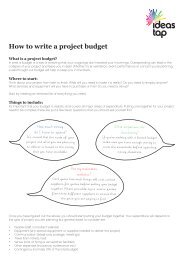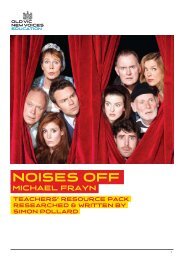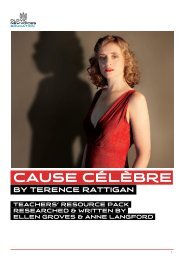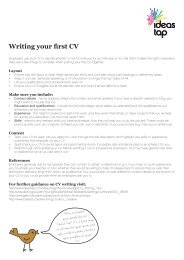How to write a press release - IdeasTap
How to write a press release - IdeasTap
How to write a press release - IdeasTap
- No tags were found...
You also want an ePaper? Increase the reach of your titles
YUMPU automatically turns print PDFs into web optimized ePapers that Google loves.
<strong>How</strong> <strong>to</strong> <strong>write</strong> a <strong>press</strong> <strong>release</strong><br />
A <strong>press</strong> <strong>release</strong>, sometimes also referred <strong>to</strong> as a media <strong>release</strong>, is a written statement used <strong>to</strong> share information with<br />
members of the <strong>press</strong>. The purpose of a <strong>press</strong> <strong>release</strong> is <strong>to</strong> inform journalists about a new product, business, or event<br />
and <strong>to</strong> convince them that it is newsworthy.<br />
Public Relations (PR) companies are often employed <strong>to</strong> <strong>write</strong> <strong>press</strong> <strong>release</strong>s and sell-in s<strong>to</strong>ries <strong>to</strong> publications on behalf<br />
of organisations. Employing such a company can be an effective way <strong>to</strong> raise your profile, but their services can also be<br />
expensive. If you can’t afford <strong>to</strong> employ a PR, you can <strong>write</strong> your own <strong>press</strong> <strong>release</strong> by following these simple steps:<br />
Layout<br />
• Format – Keep it simple and stick <strong>to</strong> a Word document or PDF when creating your document. Use bullet points <strong>to</strong><br />
highlight key facts and break down lengthy copy.<br />
• Length - A <strong>press</strong> <strong>release</strong> should be no more than two sides of A4 including pictures. Key information should be on<br />
the first page and as high up the <strong>release</strong> as possible.<br />
• Distribution date – Ensure that the date at the <strong>to</strong>p is the day the <strong>press</strong> <strong>release</strong> is sent out. It may be kept on<br />
file so it’s important for journalists <strong>to</strong> see whether information is current.<br />
• Release date - If your <strong>press</strong> <strong>release</strong> is intended for publication on a certain date, ensure that you <strong>write</strong><br />
‘Embargoed until’ and insert the date in large writing at the <strong>to</strong>p of the page.<br />
• Heading - Think of it as a newspaper headline i.e. attention grabbing but factual. A good heading will encourage<br />
people <strong>to</strong> read on.<br />
• Opening paragraph – Summarise your message in the opening paragraph – what, when, who, where, why<br />
What is the product, service or event; when and where is it being launched or happening; who is the person or<br />
company behind it and why is it exciting<br />
• Quote – Always try <strong>to</strong> include a quote as where possible journalists like hearing from people. The quote usually<br />
forms the third paragraph of a <strong>press</strong> <strong>release</strong>. Ensure that any quote is relevant and you have permission from the<br />
person you’re quoting.<br />
• Images – Adding images is particularly important if you are promoting a product or visual work. Ensure that any<br />
images you are com<strong>press</strong>ed <strong>to</strong> avoid making your file huge. You can also attach images <strong>to</strong> your email but keep any<br />
unsolicited emails <strong>to</strong> 2MB - preferably much less.<br />
• Notes <strong>to</strong> Edi<strong>to</strong>rs – A ‘Notes <strong>to</strong> Edi<strong>to</strong>rs’ section at the end of your <strong>press</strong> <strong>release</strong> is an opportunity for you <strong>to</strong><br />
provide more detail or technical information that is <strong>to</strong>o boring for the main <strong>release</strong>. It’s good <strong>to</strong> include a brief synopsis<br />
on your company in this section <strong>to</strong>o.<br />
• Contact details – Make sure that people can get hold of you for information by including your name, contact<br />
telephone number and email address.<br />
• Language - Be aware of the power of key words (e.g debut, premiere, exclusive) and delete redundant words <strong>to</strong><br />
make the <strong>press</strong> <strong>release</strong> as concise as possible. It’s also important that you <strong>write</strong> for the market/audience your product/<br />
service/event is aimed at.
Template<br />
EMBARGOED UNTIL DD MM YYYY<br />
Distribution date<br />
Snappy heading in large writing<br />
Paragraph one: summary - who, what, when, where, why<br />
Paragraph two: more detailed information.<br />
IMAGE<br />
(com<strong>press</strong>ed)<br />
Paragraph three: quote from a relevant person.<br />
Paragraph four: more detailed information.<br />
Paragraph five: closing paragraph.<br />
Notes <strong>to</strong> Edi<strong>to</strong>rs:<br />
ENDS<br />
Insert any technical/detailed information that is <strong>to</strong>o boring for the main <strong>release</strong>.<br />
Provide an overview of your company and any other parties involved in the project. It’s also useful<br />
<strong>to</strong> include a link <strong>to</strong> company websites where possible.<br />
Further information:<br />
Please contact INSERT NAME, JOB TITLE, COMPANY NAME<br />
Telephone: INSERT TELEPHONE NUMBER<br />
Email: INSERT EMAIL ADDRESS









